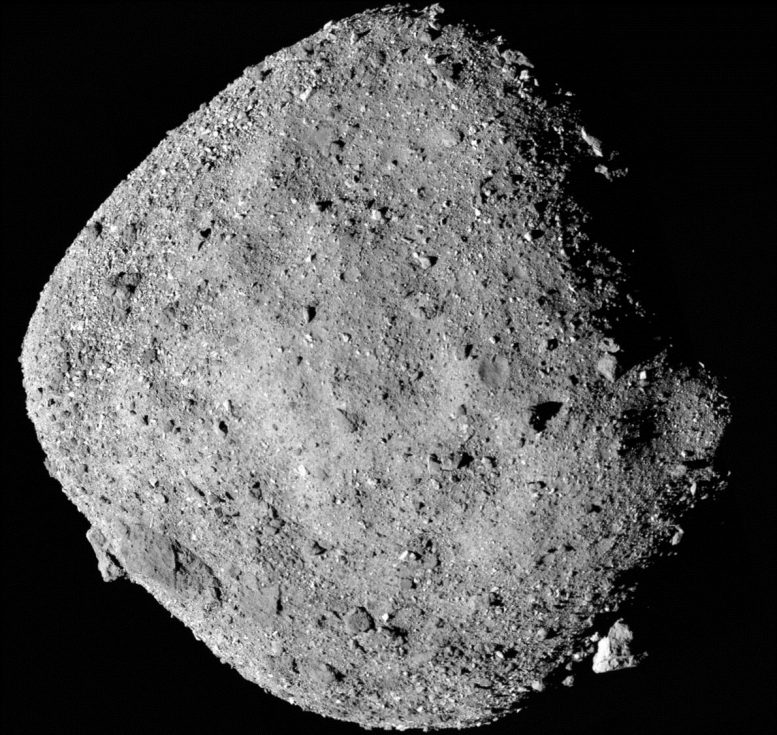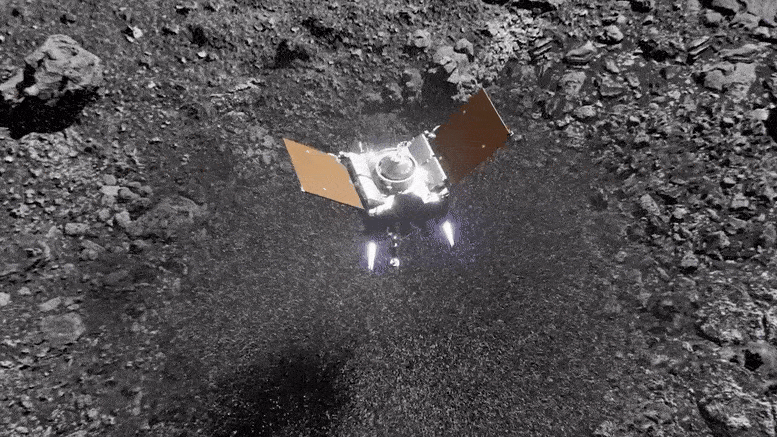Japanese scientists detected all five nucleobases — building blocks of DNA and RNA — in samples returned from asteroid Bennu by NASA’s OSIRIS-REx mission.
NASA’s OSIRIS-REx mission brought back 121.6 grams of asteroid Bennu, unveiling nitrogen-rich organic matter, including DNA’s essential bases. Scientists found differences between Bennu’s chemistry and that of meteorites like Ryugu, suggesting diverse cosmic conditions shaped their molecular makeup.
Asteroids: Ancient Messengers of Life?
Asteroids, small rocky bodies in the inner Solar System, may have played a key role in delivering water and essential chemical ingredients for life to early Earth. While meteorites that fall to Earth come from asteroids, their exposure to the atmosphere and biological contamination makes them difficult to study. The best way to analyze asteroid material is by collecting pristine samples directly from space. So far, only two countries have successfully done this: Japan, with its Hayabusa and Hayabusa2 missions, and the United States, with OSIRIS-REx.

NASA’s OSIRIS-REx Brings Bennu to Earth
In September 2023, NASA’s OSIRIS-REx mission returned 121.6 grams of material from asteroid Bennu, the largest asteroid sample ever brought to Earth. Now, an international research team led by Dr. Daniel Glavin and Dr. Jason Dworkin at NASA’s Goddard Space Flight Center has made a groundbreaking discovery: ammonia and nitrogen-rich organic compounds in the Bennu samples.
Their findings, published today (January 29) in Nature Astronomy, add weight to the theory that asteroids may have helped kick-start life on Earth. Notably, Japanese researchers on the team detected all five nitrogenous bases — key molecules needed to form DNA and RNA — inside the asteroid sample, a discovery that strengthens the idea that life’s building blocks may have originated in space.
The Bennu samples from NASA were handled under nitrogen to prevent contamination by Earth’s atmosphere. A 17.75 mg sample was processed and analyzed for N-heterocycles—organic molecules with a ring structure containing carbon and nitrogen—using high-resolution mass spectrometry at Kyushu University.

The analysis was carried out by a research team, whose members are part of the OSIRIS-REx sample analysis team, consisting of Associate Professor Yasuhiro Oba of Hokkaido University, Principal Researcher Yoshinori Takano of JAMSTEC and Keio University, Dr. Toshiki Koga of JAMSTEC, Professor Hiroshi Naraoka of Kyushu University, and Associate Professor Yoshihiro Furukawa of Tohoku University.
The analysis revealed that the concentration of N-heterocycles is approximately 5 nmol/g, 5-10 times higher than that reported from Ryugu. In addition to the five nitrogenous bases — adenine, guanine, cytosine, thymine, and uracil — required for building DNA and RNA, the researchers also found xanthine, hypoxanthine, and nicotinic acid (vitamin B3).
“In previous research, uracil and nicotinic acid were detected in the samples from asteroid Ryugu, but the other four nucleobases were absent. The difference in abundance and complexity of N-heterocycles between Bennu and Ryugu could reflect the differences in the environment to which these asteroids have been exposed in space,” Koga explains.

Clues from Other Space Rocks
Samples from the meteorites Murchison and Orgueil were also processed and analyzed previously under identical conditions for comparison. The research team observed that the ratio of purines (adenine and guanine) to pyrimidines (cytosine, thymine, and uracil) was much lower in the Bennu samples compared to both Murchison and Orgueil.
“There are multiple possible reasons for this observed difference,” Oba says. “They may be due to differences in parent bodies or formation pathways, or the Bennu asteroid was exposed to a cold molecular cloud environment where pyrimidine formation is more likely to occur.”
“Our findings, which contribute to the larger picture painted by all the authors of the paper, indicate that nucleobase chemistry in the Bennu samples must be further studied,” concluded Naraoka. Another important result of this study is that, by comparing meteorites with Bennu samples, a reference for the reanalysis of other meteorites in collections across the globe has been created.

Reference: “Abundant ammonia and nitrogen-rich soluble organic matter in samples from asteroid (101955) Bennu” by Daniel P. Glavin, Jason P. Dworkin, Conel M. O’D. Alexander, José C. Aponte, Allison A. Baczynski, Jessica J. Barnes, Hans A. Bechtel, Eve L. Berger, Aaron S. Burton, Paola Caselli, Angela H. Chung, Simon J. Clemett, George D. Cody, Gerardo Dominguez, Jamie E. Elsila, Kendra K. Farnsworth, Dionysis I. Foustoukos, Katherine H. Freeman, Yoshihiro Furukawa, Zack Gainsforth, Heather V. Graham, Tommaso Grassi, Barbara Michela Giuliano, Victoria E. Hamilton, Pierre Haenecour, Philipp R. Heck, Amy E. Hofmann, Christopher H. House, Yongsong Huang, Hannah H. Kaplan, Lindsay P. Keller, Bumsoo Kim, Toshiki Koga, Michael Liss, Hannah L. McLain, Matthew A. Marcus, Mila Matney, Timothy J. McCoy, Ophélie M. McIntosh, Angel Mojarro, Hiroshi Naraoka, Ann N. Nguyen, Michel Nuevo, Joseph A. Nuth III, Yasuhiro Oba, Eric T. Parker, Tanya S. Peretyazhko, Scott A. Sandford, Ewerton Santos, Philippe Schmitt-Kopplin, Frederic Seguin, Danielle N. Simkus, Anique Shahid, Yoshinori Takano, Kathie L. Thomas-Keprta, Havishk Tripathi, Gabriella Weiss, Yuke Zheng, Nicole G. Lunning, Kevin Righter, Harold C. Connolly Jr. and Dante S. Lauretta, 29 January 2025, Nature Astronomy.
DOI: 10.1038/s41550-024-02472-9
News
AI matches doctors in mapping lung tumors for radiation therapy
In radiation therapy, precision can save lives. Oncologists must carefully map the size and location of a tumor before delivering high-dose radiation to destroy cancer cells while sparing healthy tissue. But this process, called [...]
Scientists Finally “See” Key Protein That Controls Inflammation
Researchers used advanced microscopy to uncover important protein structures. For the first time, two important protein structures in the human body are being visualized, thanks in part to cutting-edge technology at the University of [...]
AI tool detects 9 types of dementia from a single brain scan
Mayo Clinic researchers have developed a new artificial intelligence (AI) tool that helps clinicians identify brain activity patterns linked to nine types of dementia, including Alzheimer's disease, using a single, widely available scan—a transformative [...]
Is plastic packaging putting more than just food on your plate?
New research reveals that common food packaging and utensils can shed microscopic plastics into our food, prompting urgent calls for stricter testing and updated regulations to protect public health. Beyond microplastics: The analysis intentionally [...]
Aging Spreads Through the Bloodstream
Summary: New research reveals that aging isn’t just a local cellular process—it can spread throughout the body via the bloodstream. A redox-sensitive protein called ReHMGB1, secreted by senescent cells, was found to trigger aging features [...]
AI and nanomedicine find rare biomarkers for prostrate cancer and atherosclerosis
Imagine a stadium packed with 75,000 fans, all wearing green and white jerseys—except one person in a solid green shirt. Finding that person would be tough. That's how hard it is for scientists to [...]
Are Pesticides Breeding the Next Pandemic? Experts Warn of Fungal Superbugs
Fungicides used in agriculture have been linked to an increase in resistance to antifungal drugs in both humans and animals. Fungal infections are on the rise, and two UC Davis infectious disease experts, Dr. George Thompson [...]
Scientists Crack the 500-Million-Year-Old Code That Controls Your Immune System
A collaborative team from Penn Medicine and Penn Engineering has uncovered the mathematical principles behind a 500-million-year-old protein network that determines whether foreign materials are recognized as friend or foe. How does your body [...]
Team discovers how tiny parts of cells stay organized, new insights for blocking cancer growth
A team of international researchers led by scientists at City of Hope provides the most thorough account yet of an elusive target for cancer treatment. Published in Science Advances, the study suggests a complex signaling [...]
Nanomaterials in Ophthalmology: A Review
Eye diseases are becoming more common. In 2020, over 250 million people had mild vision problems, and 295 million experienced moderate to severe ocular conditions. In response, researchers are turning to nanotechnology and nanomaterials—tools that are transforming [...]
Natural Plant Extract Removes up to 90% of Microplastics From Water
Researchers found that natural polymers derived from okra and fenugreek are highly effective at removing microplastics from water. The same sticky substances that make okra slimy and give fenugreek its gel-like texture could help [...]
Instant coffee may damage your eyes, genetic study finds
A new genetic study shows that just one extra cup of instant coffee a day could significantly increase your risk of developing dry AMD, shedding fresh light on how our daily beverage choices may [...]
Nanoneedle patch offers painless alternative to traditional cancer biopsies
A patch containing tens of millions of microscopic nanoneedles could soon replace traditional biopsies, scientists have found. The patch offers a painless and less invasive alternative for millions of patients worldwide who undergo biopsies [...]
Small antibodies provide broad protection against SARS coronaviruses
Scientists have discovered a unique class of small antibodies that are strongly protective against a wide range of SARS coronaviruses, including SARS-CoV-1 and numerous early and recent SARS-CoV-2 variants. The unique antibodies target an [...]
Controlling This One Molecule Could Halt Alzheimer’s in Its Tracks
New research identifies the immune molecule STING as a driver of brain damage in Alzheimer’s. A new approach to Alzheimer’s disease has led to an exciting discovery that could help stop the devastating cognitive decline [...]
Cyborg tadpoles are helping us learn how brain development starts
How does our brain, which is capable of generating complex thoughts, actions and even self-reflection, grow out of essentially nothing? An experiment in tadpoles, in which an electronic implant was incorporated into a precursor [...]





















